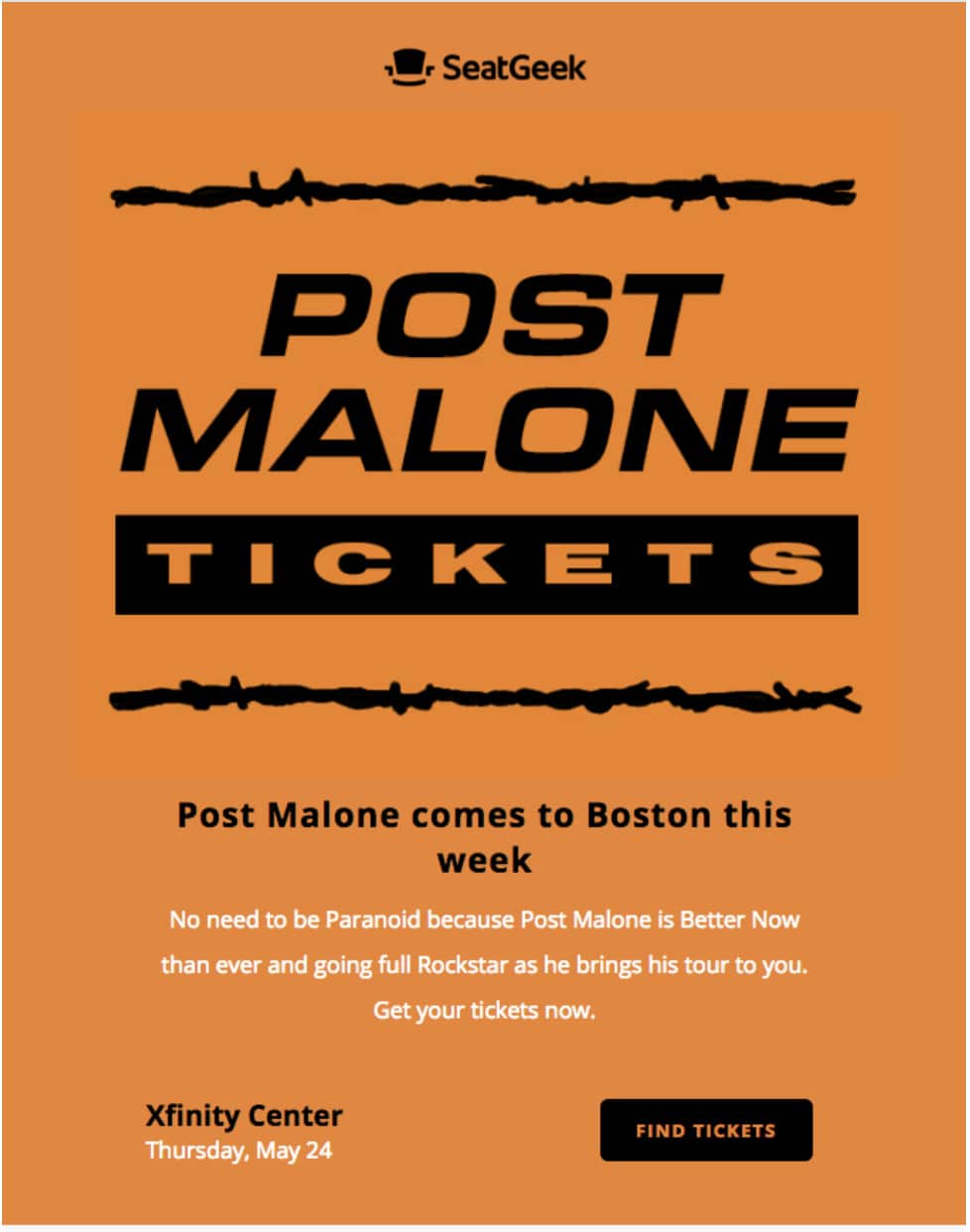Email Best Practices for the Music Industry
There’s nothing like showtime. The lights go down, the music’s turned up, and your venue is packed with an eager crowd. But you’re one of the few people who knows exactly how much work goes in before the show even starts. When you dreamed of working in the music industry, you may have imagined yourself owning a venue, putting on a show, or helping out with the band, but there are also probably a lot of roles you didn’t consider that you now fulfill, too, like marketing and show promotion.
While you’re up for wearing multiple hats, it can be overwhelming to learn everything there is to know about marketing while also running a business and getting ready for a show. And then, when you do have time to devote to promoting upcoming events, you may not be sure where to start—Social media? Paid advertising? Email marketing?
That’s where we come in. We’re here to break down everything you need to know, so you can seamlessly achieve all the items on your to-do list while still maintaining your sanity.
Why email marketing works for music
First things first: Email marketing doesn’t work only for the music industry—It consistently has the highest ROI for marketers across many industries. But because we’re focusing specifically on the music industry here, we can also explore the unique additional benefits email marketing can bring to venue owners, show promoters, and event marketers. So, why email marketing for the music industry?
Your subscribers are looking for an invitation.
While other companies may have trouble enticing people to join their subscriber list, the music industry has built-in fans and interest. You’re not asking them to sign up for insurance updates or healthcare articles—You’re asking your audience to do something fun and beneficial to them, like sign up to receive event invitations or tour information for their favorite bands.
This means you’re already ahead of the email marketing game, your audience doesn’t need a ton of convincing, and your biggest task is just to meet your target audience at the right time and place with relevant content.
Their attendance at one of your events already tells you a lot about each individual and their interests, and it’s your job to simply keep the invitations coming.
You already have great content to pull from.
Another advantage the music industry has over others is that it already has an ongoing cycle of interesting content to choose from. The seasonal nature of events means you probably already have a full schedule of upcoming shows, now it’s your job to tell the right people about them.
You don’t need to reinvent the wheel here, though. Simply listing out upcoming events in an interesting and clear way can be the key to increasing ticket sales and awareness. Instead of becoming overwhelmed by a content calendar (or lack thereof), think of it as simply an extension of your already-existing events calendar.
Every time you send an email, a tweet, or a piece of mail, it doesn’t need to include a new story or anecdote each time. Think of it like you’re holding a megaphone up to your calendar and reminding your recipients of what’s important and coming up soon.
You have a clear call-to-action.
Believe it or not, calls-to-action is where a lot of marketers can get tripped up. It can be difficult to distill a long-term marketing plan into a single call-to-action button, but, for the most part, your music goals are a little more clear. You’re probably going to want to stick with a generic “Buy tickets” or add some personality with “Count me in” or “I’ll be there.”
If the email you’re sending out isn’t calling your subscribers to purchase tickets for an upcoming event, no sweat—Just be intentional and make sure your goals are clear. This could be asking them anything from updating their newsletter preferences to visiting your website or entering a contest.
Now that you see how email marketing is a natural fit for the music industry, let’s talk specific tactics.
Best email marketing practices
Segmentation, automation, and personalization, oh my! When you’re wearing a lot of hats and unable to put any of them down, it can be overwhelming to think about increasing your email marketing efforts. But, (!) email marketing is actually supposed to work for you and make things easier, not just add to your to-do list.
So even if you’ve been sending out emails but feeling like you aren’t getting the results you hoped for, it’s important to pay attention to these best practices and continue refining your strategy. After all, if email marketing isn’t working for you, it’s not working.
1. Put your data to work.
Another name for this is segmentation, but it doesn’t have to be as complicated as it sounds. Basically, you’ve probably collected some information about your customers, from a ticket purchase or event attendance. From this, you know a few things about them, like where they live and what bands they like.
Putting this data to work means that you keep them in mind and send relevant content at the right time. So when their favorite band comes to town again or there’s a show you think they might like, you let them know. You can also use segmentation to divide your whole subscriber list into smaller groups using a specific criteria, like everyone who lives in Boston or all of the Post Malone fans.
See how Seat Geek did it:
Image: Really Good Emails
2. Personalize the experience.
The really cool thing about music lovers is that they’re also likely to love a great experience. And, luckily for them, you know just how to give a great experience from the moment they get an email in their inbox to after their very first show at your venue.
Think about the way you’d greet each newcomer at the door if you could—You’d be warm and authentic, glad they came, and probably spend time getting to know them if time allows. Spoiler alert: The key to great email marketing is the exact same thing. Take off the pressure of send times or graphic animations and focus on what it’s really all about: The relationship with your customers.
How exactly does that translate to the inbox? Use dynamic content to address subscribers by their first name, recommend shows or music they may enjoy, thank them for coming, and send them special offers for the future.
(Pro tip: The new Eventbrite + Emma integration makes it easy to sync all of your audience data from Eventbrite to your Emma email account.)
See how the Ryman makes their subscribers feel special by keeping them in the loop of recently announced shows:
3. Play the encore in the inbox.
You may be tempted to believe that once a subscriber has engaged, purchased a ticket, and attended a show, your email marketing duty is over. Not quite, but you’re almost there! Regardless of whether or not your musicians played an encore last night, the final encore and parting experience should be in the inbox soon after the event.
Thank them for coming, share a few photos from the show, and ask for feedback on the show or your email marketing. Or better yet, give them a discount off their next ticket as a thank you. It’s the final touch that really matters and will help turn first-time attendees into regulars. By showing your subscribers you’ll go the extra mile for them, their loyalty is bound to increase exponentially.
4. Reward your subscribers.
Cause A Scene is an organization in Nashville that puts on secret living-room style shows around the city. How do they share information about these shows, you may ask? Through email, of course. It’s brilliant and keeps their subscribers on their toes. By announcing shows the day or week-of, their subscribers benefit from being on the email list and the first with the opportunity to snag tickets.
What can we learn from this? Make sure it pays to subscribe to your email list. Whether it’s discounts on merchandise or the chance to be the first to hear announcements, you always want to make sure your audience is benefitting from the content you share and the messages you send. Surprise and delight them to keep your open rates high and your email list engaged.
Here’s an example email from Cause A Scene:
Then there’s this example from Marathon Music Works. They offered $20.19 tickets to their email subscribers to celebrate the new year, and it was a hit!:
5. Schedule and automate content.
Automation is one of the best ways you can make your email marketing life easier. Once you’ve got a great content strategy or events on the calendar to announce, creating an automated series will help you send content at just the right time without taking away from the rest of your to-do list.
Pro tip: One of our favorite features of the Eventbrite + Emma integration is the ability to create automated workflows. Just drag-and-drop the content you want to send into your preferred workflow and it will meet your subscribers in their inboxes at the perfect time.
See how Lollapalooza sends periodic festival updates, from announcing the tour lineup to providing more details closer to the event to get attendees excited about the festival:
Wrap up
Hopefully this post leaves you feeling like you can tackle any email marketing strategy you put your mind to—And you can! But if you’ve got a lot of inspiration with little time to execute, the best thing you can do is choose an integration that does all the heavy lifting for you. Our updated integration with Eventbrite will help you get the word out about your events, so you can get back to building a great show.
MOST RECENT ARTICLES
Want to engage your audience and grow your brand? Try Emma's robust easy-to-use product today.


















